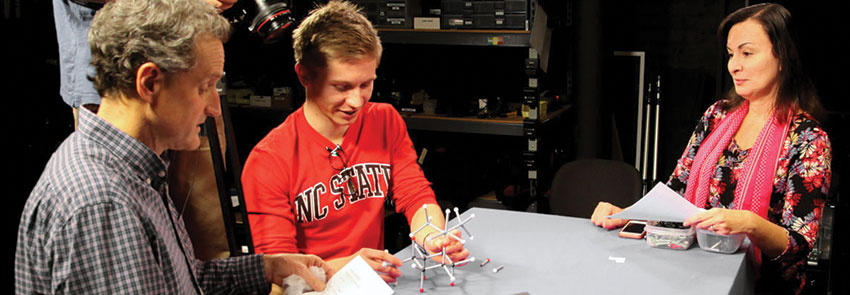
SMART Videos in CH 222/224
DELTA staff collaborated with the 2014-15 DELTA Grant recipient and director of the organic chemistry teaching laboratories, Dr. Maria Gallardo-Williams, to develop an innovative approach to video instruction. With the cooperation of more than 20 NC State students, SMART (Student-Made Audiovisuals Reinforcing Techniques) videos were developed for Chemistry CH 222 and CH 224 labs to administer a heightened lab experience for the 3,000+ students that enroll annually.
- SMART videos provide a simple and direct way to explain techniques, instruments, calculations, demonstrations and safety to students efficiently.
- Ensure teaching assistant consistency across the multiple lab sections.
- Engage students in activities that enable critical thinking skills.
Instructional Challenges
An improved way for teaching assistants to present the lab experiments to students while ensuring consistency, safety and success to NC State organic chemistry labs was needed. Students need proper instruction and demonstration, but as a result of many students attempting to watch the teaching assistant perform complex and detailed demonstrations, students were not being properly prepared for the lab experience.
Gallardo-Williams saw using short and effective video demonstrations as a logical solution. Many lab programs in the U.S. use video as a learning supplement, but she wanted these videos to be different.
Highlights and Solutions
Gallardo-Williams involved students in the creation of the videos, making them as brief and appealing as possible. What makes SMART videos innovative is that they are generated from scripts written by students, who know from personal experience what needs to be emphasized. SMART videos supplement learning in the organic chemistry laboratories by being available before and during labs, enabling students to become familiar with the procedures and techniques to focus more on the lab experiment. Students can refer to the videos on their mobile devices during labs to ensure accuracy.
Regarding the preliminary findings, Gallardo-Williams stated “Analysis of the questionnaires administered during the lab shows significant improvement after watching the videos provided. The questionnaire was broken down by category relating to each of the videos watched. Three categories of videos were introduced to students: technique, instrumentation and calculation. The questionnaire results show that students who watched the instrumentation video had a significant improvement in their understanding of the different aspects of their lab. The largest effect size was calculated for the instrumentation video, but we found positive effects in the three categories of videos that were assessed in the OEO [Operation Evaluation Observation].”
Links
For more information about DELTA services, please contact LearnTech.